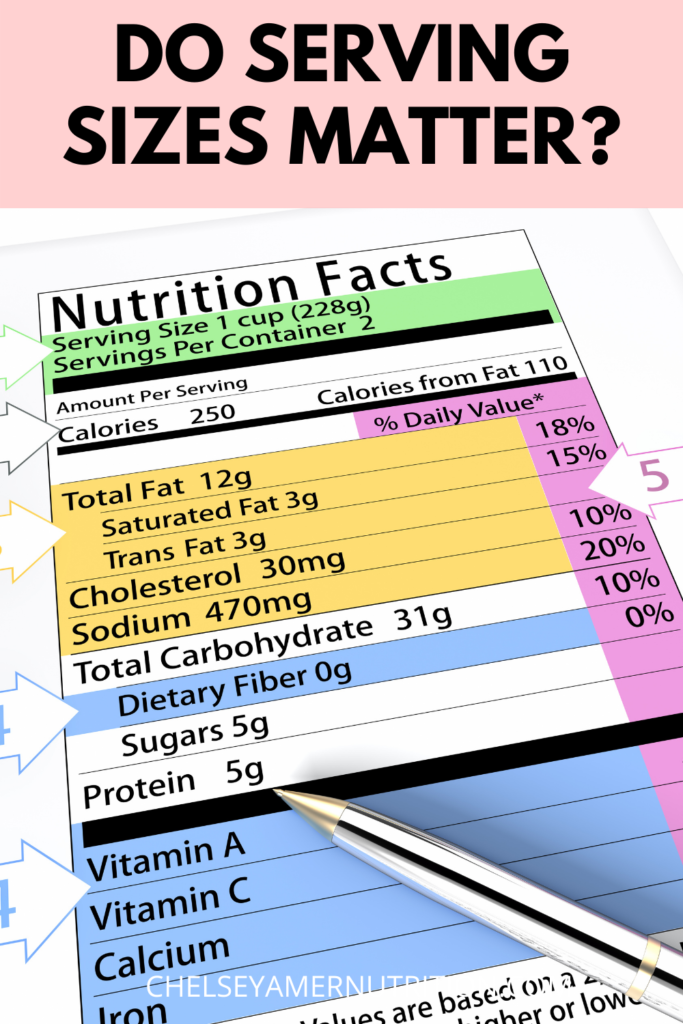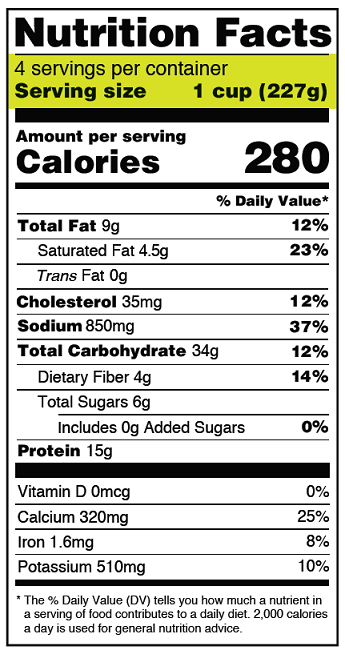Do Serving Sizes Matter?
You’re perusing the grocery aisles and check out the Nutrition Facts label to see 6 tiny crackers per serving. WHAT? Do serving sizes matter, for real? Here’s why what you need to know about how much to eat…

Have you ever poured yourself a bowl of cereal only to flip over the package and realize that a “serving size” is only 1/2 cup? You’re hungry and definitely served yourself at least double that amount… so should you only eat half of your bowl of cereal to limit your serving size to 1/2 cup?
Absolutely not!
As a registered dietitian, I’m here to answer the very common question of “Do Serving Sizes Matter?”
And my answer may surprise you…
What is a “Serving Size?”
Simply put, a serving size is the recommended amount listed on the Nutrition Facts label, suggesting how much you eat.
Said another way, the serving size is the amount for which the rest of the metrics on the Nutrition Facts label are calculated, telling you how much of each nutrient is provided per serving.
For example, if a box of cereal lists 1 cup as the serving size, the rest of the numbers on the Nutrition Facts label are for 1 cup of cereal.

It’s also (most) important to note that serving sizes are NOT how much you *should* eat.
In 2020 the Nutrition Facts labels are supposed to be updated to reflect more realistic serving sizes… AKA the amount that people actually eat. Instead of a cereal listing 1/2 cup (because no one pours 1/2 cup of cereal), the serving size should be more realistic to an average cereal “pour.”
By reflecting more realistic portions people eat, the rest of the Nutrition Facts label becomes a bit more accurate to what you’re eating.
How are Serving Sizes created?
Serving sizes are SUPPOSED to be based on the amount of food people actually eat. Over time, we’ve learned more about food consumption behaviors and Nutrition Facts labels need to stay up to date based on this info.
However, the truth is that brands can put whatever “realistic” serving size they wish on the label. Although regulated by the FDA, if the serving size is realistic, it will get the OK.
One brand of crackers may state 20 crackers per serving, but another can easily say 12 or 15. And the crackers can easily be the same size.
Do Serving Sizes Matter?
Since serving sizes are so arbitrary, the answer is a bit complicated.
Yes, serving sizes matter to let you know how many nutrients you’ve consumed.
Consider the serving sizes and Nutrition Facts label as data. In that case, serving sizes do matter to help you properly interpret the data.
Let’s take an example with crackers. Below you’ll see the Nutrition Facts labels of 2 different whole wheat crackers.

Cracker 1 on the left has a serving size of 6 crackers. For those 6 crackers you’ll consume 120 calories, 3.5g total fat, 20g carbohydrates, 3g dietary fiber, no added sugar, and 3g protein.
Cracker 2 on the right has a serving size of 5 crackers. For those 5 crackers you’ll consume 70 calories, 2.5g fat, 10g carbohydrates, less than 1 gram dietary fiber, 2g added sugars, and 1g protein.
Although the serving sizes differ by only 1 cracker, you can see some of the nutrients you’ll eat will vary.
What should you do with this information?
That’s a loaded question, but you can use it as knowledge about the nutrition in your food. You don’t need to obsess over these differences, but if you’re looking to increase your fiber intake, perhaps you choose cracker 1.
No, serving sizes don’t matter to tell you how much to eat!
There’s a big misconception that serving sizes are designed to tell you how much to eat, as in “You should ONLY eat 5 crackers because that’s what’s listed on the label.” This could not be further from the truth.
The serving sizes on a Nutrition Facts label are there as data, as I mentioned above. It’s a reflection of what a brand *thinks* is the average amount people actually consume.
But that’s very different from telling you what to eat.
So no, serving sizes don’t matter when it comes to guiding how much to eat.
You can eat a half serving size, a full serving size, double the serving size, triple the serving size, or more!
How should you determine how much to eat?
My favorite way to teach clients to determine how much to eat is to get in touch with their hunger and fullness cues.
Eat when you’re hungry, stop when you’re full (*most* of the time).
Over time, getting in touch with these cues can help you know how much to eat without micromanaging the numbers.
Do Serving Sizes Matter takeaway
Serving sizes are a tool available to you – but they’re not the ONLY tool, or I’d even argue the most important tool. Instead, view serving sizes as a way to gather data. Use your own intuition as the most important tool in your arsenal.
Have questions about how to read a Nutrition Facts label? Join the Nutrition Training Program self-paced option to start learning today!
XO


 Hi there!
Thanks for stopping by! I'm Chelsey, an online Registered Dietitian, recipe developer, budding photographer, and coffee addict! My mission is to help you feel good through food by answering the question "What should I eat?" Let's make nutrition approachable!
I hope you enjoy my personal collection of simple, healthy, food allergy friendly and nutritiously delicious recipes, plus tips and tons of tricks that will help YOU live a nutritionally-balanced life! I look forward to getting to know you better...
Hi there!
Thanks for stopping by! I'm Chelsey, an online Registered Dietitian, recipe developer, budding photographer, and coffee addict! My mission is to help you feel good through food by answering the question "What should I eat?" Let's make nutrition approachable!
I hope you enjoy my personal collection of simple, healthy, food allergy friendly and nutritiously delicious recipes, plus tips and tons of tricks that will help YOU live a nutritionally-balanced life! I look forward to getting to know you better...







